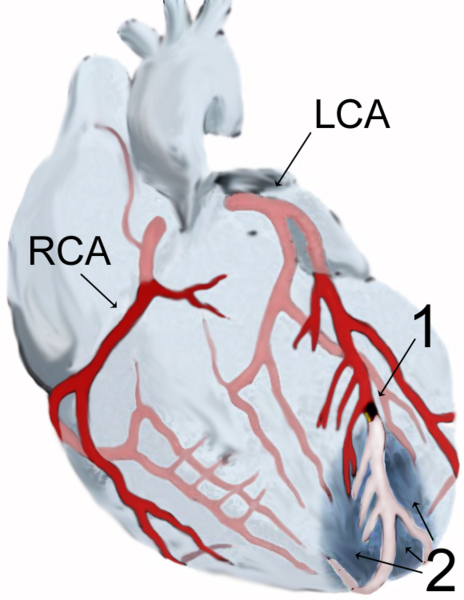Barriers to Implementing Clinical Guidelines
| Myocardial infarction | |
 | |
|---|---|
| Diagram of a myocardial infarction (2) of the tip of the anterior wall of the heart (an apical infarct) after occlusion (1) of a branch of the left coronary artery (LCA, right coronary artery = RCA). | |
| ICD-10 | I21-I22 |
| ICD-9 | 410 |
| DiseasesDB | 8664 |
| MedlinePlus | 000195 |
| eMedicine | med/1567 emerg/327 ped/2520 |
Editor-In-Chief: C. Michael Gibson, M.S., M.D. [1]
Associate Editors-In-Chief: Cafer Zorkun, M.D., Ph.D. [2]
Multiple factors have been linked to poor adherence to applications of clinical statements and treatment guidelines. Non teaching or for profit hospitals tend to score lower than academic or not for profit hospitals. This translates into a survival advantage for teaching over non teaching hospitals, which is attenuated but not eliminated by controlling for baseline patient characteristics. It appears that hospital therapy tradition and structure of care play significant roles in the different outcome among hospitals.
In fact, in a study of Medicare patients who had acute myocardial infarction (AMI) treated in 1994 and 1995, admission to a hospital ranked high on the ‘‘America’s Best Hospitals’’ list published annually by the US News & World Report was associated with a lower 30 day mortality, linked to a higher rate of use of aspirin and beta blockers by these hospitals.
It is interesting that most studies looking at outcome by treating physician found that the outcome of AMI patients is better when the care is assumed by a cardiologist. Although specialists may be treating patients with less comorbid conditions, attempts to adjust for baseline patient characteristics did not eliminate the difference in in-hospital or one year mortality. It is the better implementation of recommended medical therapy and the higher use of reperfusion therapy by cardiologists that could account for most of the observed difference in outcome. Although this finding calls for better implementation of the guidelines by all treating physicians, it does not justify a universal call on all AMI patients to be cared for by cardiologists only.
The factors that may prevent a physician from applying the guidelines are complex and poorly understood.
1. The physician may simply be unaware of the presence of the guidelines,
2. The physician may be unfamiliar with contents of guidelines.
3. The physician aware of the recommendations, clinical statements and guidelines, but may disagree with the guidelines,
4. The physician believe that guidelines and clinical statements are overwhelming and confusing, and have poor outcome expectancy,
5. The physician may find it hard to change practices she/he already used to.
Reference:
1. Singh M., Holmes D. R., Acute Myocardial Infarction, Med Clin N Am 91 (2007)